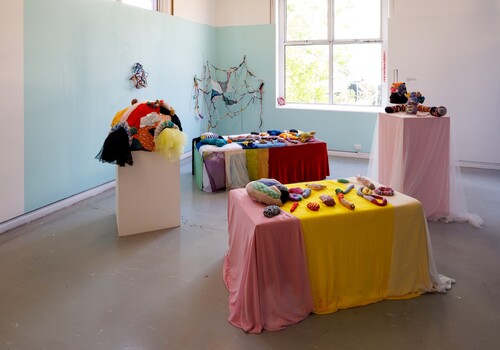Photography, Painting, Honours, Victorian College of the Arts
By Giles Fielke
Installed in well-lit galleries, video works often fail to capture audience attentions. When they do, however, they really do. Two works in this year’s VCA graduate exhibition stopped me dead in my tracks: Eleanor Newbound’s No Harm In Pretty Things and Jay Paul Harrison’s Guilty. In the broadest sense, these vibrant indulgences in colour appear to emblematise many of the 2021 exhibits, despite or even because of the dreary monotony of the pandemic era.
Harrison’s gleeful framing of Port Melbourne Beach and foreshore as some kind of sinister crime-scene romance, glorified with a sumptuous soundtrack and across three screens, was chosen as the hero-image for the entire graduate exhibition. This lent it some credit, but also raised my expectations for the visit. I was not disappointed. The saturation of colour and the darkened photography seminar room punctuated by saturated synths recalled the Giallo films of Dario Argento, while the central actor channels the manic energy of Sam Neill in Andrzej Żuławski’s Possession. This was shot on hi-res video, however, detailed for the zoom-generation.

Guilty (three-channel digital video) could be seen to offer a narrative alternative to the intimate logic of Newbound’s No Harm In Pretty Things (digital video, 10mins 35secs). Five women—the same person—all wear dunce’s caps and feed each other cakes before they set a remote castle on fire. I have to confess: my partner studied at the VCA with Newbound’s father, so I was intrigued to know more. That I realised this after the fact allows me to return to my initial fascination with the work, untarnished by any expectations I may have had. But it now gives the work a certain weight of understanding; an intergenerational collaboration must have occurred here, some transmission at least: where Mark’s films are meticulously observational, Eleanor’s is a dream sequence that comes out of her painting practice and interest in images and the haptic and auratic textures of adolescence.
Jiggling jellies slip between curious fingers, penetrating flowers encased in translucent gelatin. Pomegranate seeds placed in baking moulds produce dainty effects amongst the dyed goods. The colour of cakes and flora blend into the edibles. Věra Chytilová’s Sedmikrásky (Daisies, 1966) is a key reference for Newbound’s film, and it is the combination of the Czech New Wave’s blue-tinged, cold-but-vital colours with what I can only describe as ‘Round the Twist’-era television effects (in-camera animations, travelling matte’s on set) that makes the work so compelling. It was all shot during lockdown, at home, Newbound sourced the images that provide the ground of the action from the web. Over the phone she tells me: “if you think of an image you want, it’s possible to find it on the internet, if you search long enough.” Closed-off in a darkened room, the no-frills installation (a digital projection) also compels the viewer otherwise inundated with graduate works outside.

My recent attraction to more conservative forms of art-making, away from experimentation is an effect, I think, of the assimilation of experimentation into everyday life. Absolutely everything is some form of experiment: our governance, our social relations, our public health orders. This proliferation and normalisation of experimentation has driven me, and many others I imagine, towards more stable work—a radical conservatism, perhaps—but the significance of a discipline in practice remains. Work with substance is what we’re dying for, not shallow iterations of prior echoes. Chytilová’s Catholicism, or the 90s fusion of transcendence and commerce—a la Baz Luhrmann’s Romeo + Juliet, perhaps—is where my mind goes. Not least it’s an interest in classical escapism, in myth and form.
Knocking me right out was Ashley Perry’s Masters exhibition, which includes Precipitation, one part of a suite of works delicately exposing the troubling foundations of our impulse to archive. Using conduit racks lowered to eye-level as supports and filled with Raspberry Pi[e]s (credit-card sized computers running imaging programs created by the artist) alternating with cabling and flatscreens showing digital scans of objects in the collections, Perry suggests this new (pandemic) time has been spent productively, eviscerating and probing the practice of institutions that are normally operating too fast to notice in any detail.

Perry’s work is powerful, not nostalgic. Uncredited, an image of Perry’s installation appears as part of the VCA press release for the graduate exhibition—it contains quotes from Lisa Waup, a Gunditjmara and Torres Strait Islander woman and multidisciplinary artist whose work involves directional signs pointing back to ancestral heritage. Perry’s work asks questions more difficult to answer, wordless and irascible—eg. how did this “semi-oval woven basket with cord of twisted weft (prior to 1861)” find its way into the Pitt Rivers Museum (at the University of Oxford)? Perry is a Goenpul artist from Quandamooka country whose uneasiness with the institutions of colonisation—the university in particular—is palpable. One work, Reconnaissance Object disguised as Country Observes, takes photos of you while viewing the sculptural object close-up, observing its multimedia construction for signs of life. And this may be the point: it’s the best works that stare back. I almost bashed my head on the low-slung “i” on the way out.
Giles Fielke is an editor of Memo Review



















